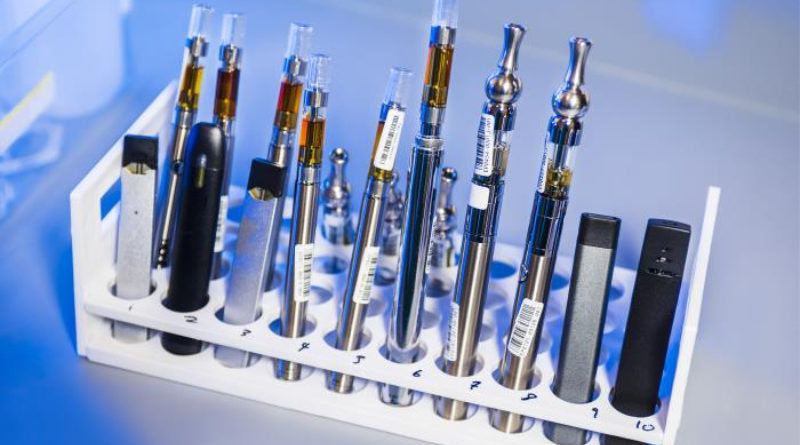Doctors See Vaping as Another Deadly Habit
- Inhaling “vaporized poison” causes chemical burns in lungs
- Most teens, and many adults, are unaware of the dangers
- A third of Dallas county EVALI cases have been 18 or younger
A Dallas teen died at the end of last year from a lung injury associated with the use of E-cigarettes, or vaping, and Dallas County health officials say about a third of all other cases have been patients younger than 18.
Dallas County Health and Human Services said that as of Dec. 30, 2019, the agency had received 53 reports of patients hospitalized with EVALI, or E-cigarette, or Vaping, Associated Lung Injury. Of those 53, 45 percent were younger than 21, and 72 percent were male.
The median age, the county said, is 22 years, but the cases range in age from 13 years old to 52. One case, officials said, was a teen who reported only starting vaping a month prior.
“Reporting a death in a teen due to EVALI is so tragic”, said DCHHS Director Dr. Philip Huang “We are seeing that severe lung damage, and even death, can occur with just short term use of these products.”
Dr. Mitch Magee, the surgical director of thoracic oncology at Medical City Dallas, said he’s been ringing the alarm bells regarding the dangers of vaping for a while. He likens the misconceptions and marketing around e-cigarettes to the early years of cigarette sales, when tobacco products were touted as safe and sometimes even healthy.
“That’s exactly what’s going on right now with e-cigarettes, and the epidemic, in particular, that’s been going on with our kids,” Magee said, adding that smoking, in general, has declined in the U.S.
Magee, who has a child in high school, said he frequently finds that parents and teens are unaware of the dangers, too.
“I talk to parents of kids at social gatherings, and you know, it’s amazing to me how educated people can be so uninformed about something as dangerous as e-cigarettes,” he said. “A large percentage of high school kids right now don’t even know that all of these products contain nicotine, and how they work.”
What makes e-cigarettes so dangerous, Magee said, is that when the vapor is inhaled, “you’re inhaling vaporized poison that causes a chemical burn to the inside of the lung.”
And in many cases, he said, users have used THC-containing vaping products, and the CDC reports that 78 percent of cases reported buying those products from “informal” sources – not regulated ones.
Those unregulated sources often “cut” their products with things that may be causing or exacerbating EVALI, too, things like vitamin E acetate and other additives.
Is there a “safe” way to vape? Magee said that originally, e-cigarettes were designed to help smokers quit gradually. “If you’re going to use these products buy them over the counter, use them as the manufacturer intended and FDA-approved to be used, don’t add any products in, and use them as little as possible,” he said.
Those who are concerned about their health after using an e-cigarette or vaping product, should contact your healthcare provider or local poison control center at 1-800-222-1222.
An extended interview with Dr. Magee follows. It has been edited for clarity and length.
PN: First, now that Dallas County has reported its first EVALI death – and it’s a teen – we were hoping you could explain what experts believe is making people so sick.
MM: This has been of major interest of mine for quite some time. You know, I’m a cardiothoracic surgeon. A large percentage of what I treat is smoking-related injuries. Lung cancer, in particular, is a large part of my practice.
And as you might imagine, a large percentage of my patients that I see with lung cancer are smokers. And, you know, a lot of what we’re seeing now with e-cigarette use is reminiscent of where we were talking about tobacco products back in the 60s and 70s, when everybody was using them and everyone was under the misconception that there weren’t any health-related problems with them. And really, there was more hidden and less actually known (about the dangers) than what was known at the time.
That is exactly what’s going on right now with e-cigarettes and in the epidemic, in particular, that has been going on with our kids. Smoking in general across the United States has declined over the last couple of decades. And that was certainly beneficial.
But e-cigarette use, you see statistics with a large percentage of middle school and high school students that are using – it’s up over 20%.
Just as I talk to – in social gathering things – when I talked to parents of kids that are my age, you know, I’ve got a high schooler, it’s amazing to me how educated people can be so uninformed about something as dangerous as e-cigarettes. A large percentage of high school kids right now don’t even know that all of these products containing nicotine and that they work.
We know a lot about combustible tobacco products and how they affect us. We also know that the major addictive factor in tobacco is nicotine. That’s the major factor in e-cigarettes as well. So e-cigarettes are just as addictive. One e-cigarette is equal to a pack of cigarettes in terms of nicotine concentration.
PN: So what exactly is causing EVALI?
MM: What essentially happens is when you inhale, well, hot vapor. Basically, you’re inhaling a liquid vaporized poison that causes a burn, a chemical burn, to the inside of the lung. The most recent evidence suggests – after looking at the types of chemicals that can be recovered from these lungs, compared to people who don’t have any injury – the common factor seems to be a vitamin E acetate which is an oil-based vitamin.
And vitamin E acetate oil is commonly used to “cut” THC illicit products that are sold. And by cut, I mean it’s basically a way to dilute the THC and contaminate the THC pods to make it look like you’re getting more than what you actually are getting.
So when you inhale the vapor, you’re inhaling a hot oil. If you’re heating oil up to vaporize it and then inhale it, you can imagine what it could do to the inside of your lungs if you’re inhaling burning oil.
And the common factor here among all the people that ended up with people with lung injuries – over 75% of those patients admitted to having added to their e-cigarettes a THC product, and a large majority of those were illicitly obtained.
PN: How are we not seeing this with other non-cigarette ways people take in tobacco or marijuana, like hookahs or water pipes?
MM: There are a couple of reasons we don’t see these injuries with hookahs. One, the number of people and the variety of people that are using these e-cigarettes is huge compared to the small percentage of the population was going into a hookah bar and using one of these more regulated type of a delivery system and more consistent.
And two, now, you’ve got a whole bunch of young people, you know, irresponsible kids, basically young adults and teenagers that think they’re invincible, that think that smoking a THC product is safer and not as dangerous and not as a health hazard than smoking a cigarette. And in fact, we don’t know. Not only do we not know what the immediate effects may be on that particular individual in their immune system, we certainly don’t know the long term effects.
PN: It seems like at first, e-cigarettes were even recommended by doctors for patients that were trying to quit smoking. What changed?
MM: That is the irony of it. They were first approved and manufactured as an aide to quitting smoking. And in fact there have been a lot of large studies – the most important one came out of Great Britain – which showed that indeed cigarette smokers that started using e-cigarettes did effectively quit using cigarettes, but they became addicted to the e-cigarettes instead. It was a small percentage of people that actually used the e-cigarettes to get off of the nicotine habit entirely.
And of course, we know that not only does it not help kids stop smoking or keep them from starting smoking. Suddenly five percent of kids would use e-cigarettes go on to smoke as an adult. So it actually does get the kids hooked because nicotine is much of a factor or more of a factor in e-cigarettes.
So all these kids are getting addicted to nicotine, whereas smoking is going down in the general population, it’s going up dramatically in kids. And this is creating a whole new generation of smokers that we’re going to have going forward that we have been fighting for two decades now to get rid of.
PN: Obviously, you know, it’s not just teens and young adults using and using these, but it seems like we the most news reports about EVALI occurring with younger people. Statistically is it really that much or is it just that’s what we hear about the most?
MM: I think that it’s both. I think it’s the kids that are using these THC products more often and abusing them because they’re getting them illicitly because it’s illegal for the kids to be having them in any form. They’re young and they’re irresponsible. And so they’re more likely to be using adding things to the e-cigarettes, perhaps more so than an adult who is using these e-cigarettes more responsibly to try to get off of cigarettes or to try to transition from cigarettes to e-cigarettes and then hopefully off ultimately.
I think frankly, of course, is much more tragic, you know, when we see a young, healthy person who’s having a life-threatening illness, and so it makes much more newsworthy. So I think it’s a combination of both things.
PN: Is there a way to vape responsibly?
MM: So my answer is that the most responsible way to use e-cigarettes is to use them in the way that they were manufactured and designed to be used, and that is to help someone get off of cigarettes and stop smoking. If you’re not smoking now, don’t start, don’t use e-cigarettes. We don’t know not only what the potential short term implications are, but more importantly, the long term implications of using those products.
So in that respect, there was no real safe way to vape. But if I knew my kid was already addicted to e-cigarettes, I would say if you’re going to use these products don’t add anything to them, buy them over the counter, use them as they are manufactured and FDA approved to be used, and don’t put any other products in the pod, and use them as little as possible.









